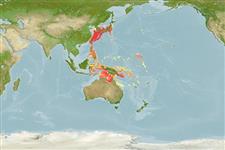Common names from other countries
Elasmobranchii (tubarões e raias) (sharks and rays) >
Carcharhiniformes (Ground sharks) >
Triakidae (Houndsharks) > Galeorhininae
Etymology: Hemitriakis: hemi-, from hemisys (Gr.), half, being a genus that Herre believed was “most closely related” to Triakis. (See ETYFish); japanica: -ica (L.), belonging to: Japan, type locality. (See ETYFish).
More on authors: Müller & Henle.
Environment: milieu / climate zone / depth range / distribution range
Ecologia
marinhas demersal; intervalo de profundidade 20 - 345 m (Ref. 86942). Subtropical; 40°N - 19°N, 112°E - 141°E
Northwest Pacific: China, Taiwan, Korea, and Japan. Nominal records from Ambon, Indonesia (unconfirmed and based on a specimen close to if not identical to Hemitriakis abdita) and New Caledonia (Ref. 13563).
Length at first maturity / Tamanho / Peso / Idade
Maturity: Lm 91.5, range 81 - 102 cm
Max length : 110 cm TL macho/indeterminado; (Ref. 244); 120.0 cm TL (female); Idade máx. registada: 15 anos (Ref. 9031)
Occurs close inshore and offshore down to at least 100 m depth. Presumably feeds on small fishes, cephalopods and crustaceans. Ovoviviparous, with 8 to 22 young in a litter. Size at birth about 20 to 21 cm. Utilized for human consumption.
Ovoviviparous, embryos feed solely on yolk (Ref. 50449).
Compagno, L.J.V., 1984. FAO Species Catalogue. Vol. 4. Sharks of the world. An annotated and illustrated catalogue of shark species known to date. Part 2 - Carcharhiniformes. FAO Fish. Synop. 125(4/2):251-655. Rome: FAO. (Ref. 244)
Categoria na Lista Vermelha da IUCN (Ref. 130435)
CITES (Ref. 128078)
Not Evaluated
Ameaça para o homem
Harmless
Utilização humana
Pescarias: espécies comerciais
Ferramentas
Relatórios especiais
Descarregue XML
Fontes da internet
Estimates based on models
Preferred temperature (Ref.
115969): 9.7 - 27, mean 20.2 (based on 252 cells).
Phylogenetic diversity index (Ref.
82804): PD
50 = 0.5156 [Uniqueness, from 0.5 = low to 2.0 = high].
Bayesian length-weight: a=0.00427 (0.00183 - 0.00992), b=3.04 (2.83 - 3.25), in cm Total Length, based on LWR estimates for this (Sub)family-body shape (Ref.
93245).
Nível Trófico (Ref.
69278): 4.4 ±0.4 se; based on diet studies.
Resiliência (Ref.
120179): Muito baixo, tempo mínimo de duplicação da população maior que 14 anos (Fec=8).
Fishing Vulnerability (Ref.
59153): High to very high vulnerability (72 of 100).
